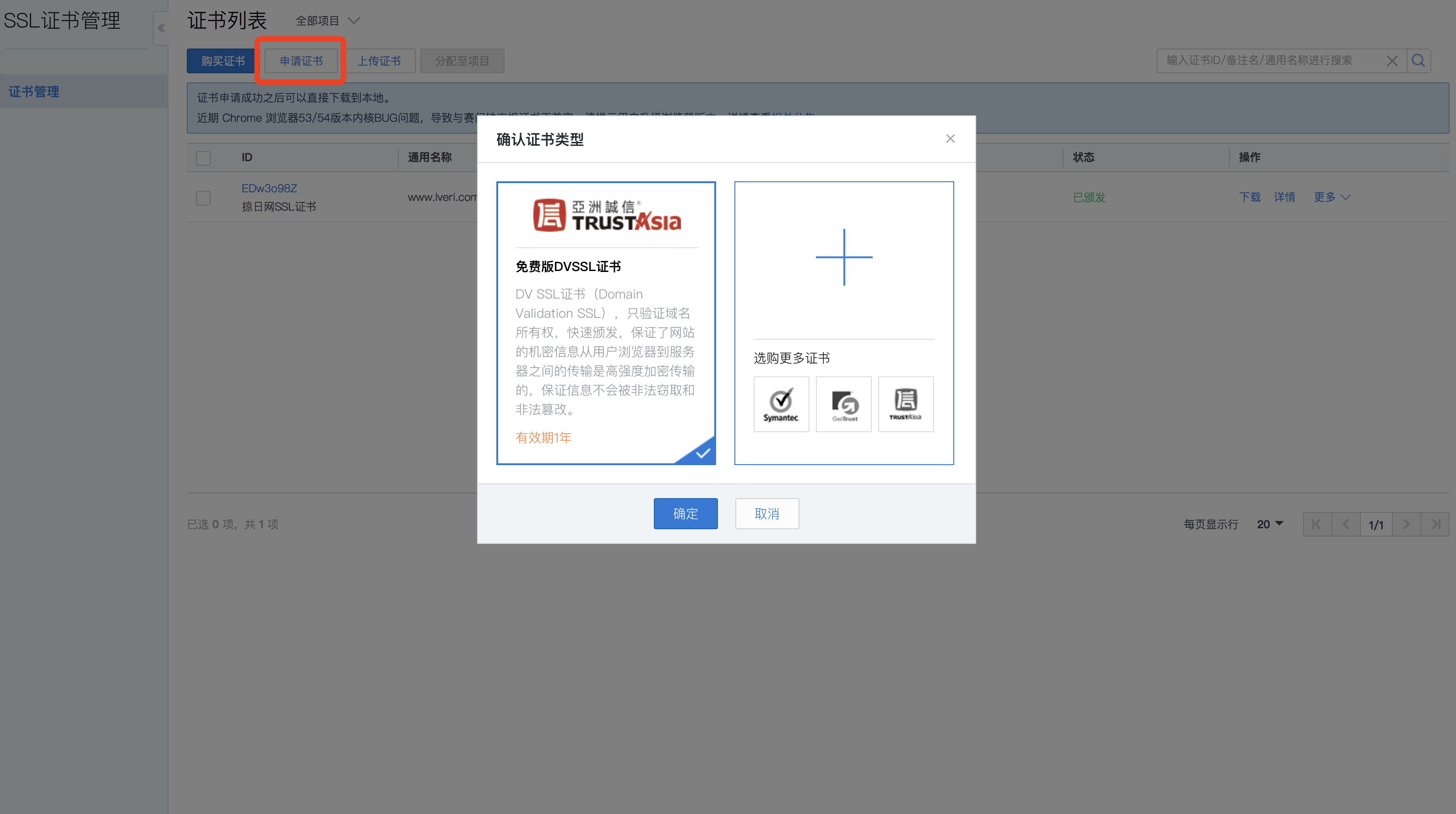[从零开始搭网站六]为域名申请免费SSL证书(https),并为Tomcat配置https域名所用的多SSL证书
2017-09-14 23:54
1066 查看
点击下面连接查看从零开始搭网站全系列
从零开始搭网站
由于国内的网络环境比较恶劣,运营商流量劫持的情况比较严重,一般表现为别人打开你的网站的时候会弹一些莫名其妙的广告...更过分的会跳转至别的网站.
那么为了解决这种情况,那么我们就要申请SSL证书,并且配置服务器.
并且,我准备再学习并写一个微信小程序,而微信小程序所有接口都需要走https,那么全线https就势在必行.
目前免费https其实有很多家,我之前出过一个教程是 用Let's Encrypt实现Https(Windows环境+Tomcat+Java) ,这个我现在也不准备用了,一是我现在开发环境从windows server换成了Linux,二是现在找到了更好用的免费SSL证书.
我推荐大家使用两家的免费SSL证书,一个是阿里云的,一个是腾讯的(当然,实际上都是赛门铁克的证书,我说他俩只是在他俩家可以免费买).免费的安全性,权威性肯定要差一点,但是我们个人建站挂个https就足够了.如果有需要,这两家有付费的更好的选择.
1:由于我是阿里云重度依赖用户嘛,所以我们先打开阿里免费证书发放的网站: https://www.aliyun.com/product/cas?spm=5176.8142029.388261.255.b1KqKz
或者可以在管理控制台产品里在这找到:

2:点立即购买,选择免费型:

3:去支付-->立即付款-->跳转至证书控制台-->补全-->嗯...........................本地教程到此结束谢谢大家(开玩笑的下面还有)

4:难道就因为这世界上有一个牌子是LV?所以我就不能给LV域名上SSL证书?还是因为绿绿?宗教歧视?阿里你这不清真啊,从你阿里旅行改名叫飞猪我就看出来了,你们阿里不是一家清真公司,哼!我们转投腾讯好了.
5:打开腾讯云证书管理页面: https://console.qcloud.com/ssl 申请证书

6:填写子域名和申请邮箱,密码和备注都可以不写

7:下一步,强烈建议选择手动DNS解析,硬要选择文件验证的...那你选吧我也拦不住...
8:确认申请-->查看证书详情,如下图所示:

9:去你的域名DNS解析那里添加一条这样的解析,如下图所示:

10:返回你的证书列表,等人家给你发邮件和短信就行了,我申请的这两都在1分钟之内通过了,非常快速,差点图都截不上了.

11:证书申请好了,接下来该往tomcat里配置了,这里腾讯官方说的很明白,我就不献丑了,直接上官方文档吧 : https://www.qcloud.com/document/product/400/4143#4.-tomcat-.E8.AF.81.E4.B9.A6.E9.83.A8.E7.BD.B2
12:别急,还没完,我这么长的男人,怎么会到此结束了,下面还有很长呢
13:好,大家现在想一个问题,经过第11步官方文档的配置,你所有请求都走了443端口,验证了443端口所配的SSL证书了.可是.由于咱们申请的是单域名证书,而tomcat里明明可以配置多域名多项目,目前来看一个端口只能配一个证书,那么你其他网站怎么办,你其他有证书的域名怎么往tomcat里配呢?这就是我接下来要说的了----单tomcat,单ip,配多SSL证书
14:网上的各种教程都是在要么配多tomcat,要么tomcat里配多IP,这样就可以有多个443端口,导致我一度认为实在是没有办法配单tomcat单SSL证书了.但是我之前知道nginx可以配置多SSL证书,我就去查了一下,原来原理是打开SNI设置,那么tomcat支不支持呢?经过查证,8.5以上的版本也支持SNI,这就很开心了(8.5以下是实在没有办法了,要不然你们升级tomcat版本跟我这个教程走,要不然再配一个nginx,请求先走ngnix代理一下)
15:经过数小时的摸索,查阅了百度,谷歌等网站,由于tomcat9.0版本很新,使用的人很少(大多数人还是老版本不出错就用老版本呐...),查到的资料比较少,结合一点点的信息,再加上官方网站: http://tomcat.apache.org/tomcat-9.0-doc/config/http.html#SSL_Support_-_SSLHostConfig 和 https://tomcat.apache.org/tomcat-9.0-doc/ssl-howto.html 网站后,终于让我的两个证书都能在tomcat里生效,在这里我贴出我的server.xml 大家复制粘贴过去,对应修改就好了,配置非常简单(但是在调试通之前是非常的痛苦,log的日志信息非常的少,中英文能参考的文献也非常的少)
配置ssl证书这里,.jks文件是腾讯云提供给你下载的,把这个文件放在服务器/usr/tomcat/conf路径下,后面那个密码如果你在申请证书的时候填了就是那个,没填就是下载下来跟.jks文件在一起的另一个文件.
16:终于完了,几乎可以算是国内出tomcat配置多SSL证书教程的前几人了...
从零开始搭网站
由于国内的网络环境比较恶劣,运营商流量劫持的情况比较严重,一般表现为别人打开你的网站的时候会弹一些莫名其妙的广告...更过分的会跳转至别的网站.
那么为了解决这种情况,那么我们就要申请SSL证书,并且配置服务器.
并且,我准备再学习并写一个微信小程序,而微信小程序所有接口都需要走https,那么全线https就势在必行.
目前免费https其实有很多家,我之前出过一个教程是 用Let's Encrypt实现Https(Windows环境+Tomcat+Java) ,这个我现在也不准备用了,一是我现在开发环境从windows server换成了Linux,二是现在找到了更好用的免费SSL证书.
我推荐大家使用两家的免费SSL证书,一个是阿里云的,一个是腾讯的(当然,实际上都是赛门铁克的证书,我说他俩只是在他俩家可以免费买).免费的安全性,权威性肯定要差一点,但是我们个人建站挂个https就足够了.如果有需要,这两家有付费的更好的选择.
1:由于我是阿里云重度依赖用户嘛,所以我们先打开阿里免费证书发放的网站: https://www.aliyun.com/product/cas?spm=5176.8142029.388261.255.b1KqKz
或者可以在管理控制台产品里在这找到:

2:点立即购买,选择免费型:

3:去支付-->立即付款-->跳转至证书控制台-->补全-->嗯...........................本地教程到此结束谢谢大家(开玩笑的下面还有)

4:难道就因为这世界上有一个牌子是LV?所以我就不能给LV域名上SSL证书?还是因为绿绿?宗教歧视?阿里你这不清真啊,从你阿里旅行改名叫飞猪我就看出来了,你们阿里不是一家清真公司,哼!我们转投腾讯好了.
5:打开腾讯云证书管理页面: https://console.qcloud.com/ssl 申请证书

6:填写子域名和申请邮箱,密码和备注都可以不写

7:下一步,强烈建议选择手动DNS解析,硬要选择文件验证的...那你选吧我也拦不住...
8:确认申请-->查看证书详情,如下图所示:

9:去你的域名DNS解析那里添加一条这样的解析,如下图所示:

10:返回你的证书列表,等人家给你发邮件和短信就行了,我申请的这两都在1分钟之内通过了,非常快速,差点图都截不上了.

11:证书申请好了,接下来该往tomcat里配置了,这里腾讯官方说的很明白,我就不献丑了,直接上官方文档吧 : https://www.qcloud.com/document/product/400/4143#4.-tomcat-.E8.AF.81.E4.B9.A6.E9.83.A8.E7.BD.B2
12:别急,还没完,我这么长的男人,怎么会到此结束了,下面还有很长呢
13:好,大家现在想一个问题,经过第11步官方文档的配置,你所有请求都走了443端口,验证了443端口所配的SSL证书了.可是.由于咱们申请的是单域名证书,而tomcat里明明可以配置多域名多项目,目前来看一个端口只能配一个证书,那么你其他网站怎么办,你其他有证书的域名怎么往tomcat里配呢?这就是我接下来要说的了----单tomcat,单ip,配多SSL证书
14:网上的各种教程都是在要么配多tomcat,要么tomcat里配多IP,这样就可以有多个443端口,导致我一度认为实在是没有办法配单tomcat单SSL证书了.但是我之前知道nginx可以配置多SSL证书,我就去查了一下,原来原理是打开SNI设置,那么tomcat支不支持呢?经过查证,8.5以上的版本也支持SNI,这就很开心了(8.5以下是实在没有办法了,要不然你们升级tomcat版本跟我这个教程走,要不然再配一个nginx,请求先走ngnix代理一下)
15:经过数小时的摸索,查阅了百度,谷歌等网站,由于tomcat9.0版本很新,使用的人很少(大多数人还是老版本不出错就用老版本呐...),查到的资料比较少,结合一点点的信息,再加上官方网站: http://tomcat.apache.org/tomcat-9.0-doc/config/http.html#SSL_Support_-_SSLHostConfig 和 https://tomcat.apache.org/tomcat-9.0-doc/ssl-howto.html 网站后,终于让我的两个证书都能在tomcat里生效,在这里我贴出我的server.xml 大家复制粘贴过去,对应修改就好了,配置非常简单(但是在调试通之前是非常的痛苦,log的日志信息非常的少,中英文能参考的文献也非常的少)
配置ssl证书这里,.jks文件是腾讯云提供给你下载的,把这个文件放在服务器/usr/tomcat/conf路径下,后面那个密码如果你在申请证书的时候填了就是那个,没填就是下载下来跟.jks文件在一起的另一个文件.
<?xml version='1.0' encoding='utf-8'?> <!-- Licensed to the Apache Software Foundation (ASF) under one or more contributor license agreements. See the NOTICE file distributed with this work for additional information regarding copyright ownership. The ASF licenses this file to You under the Apache License, Version 2.0 (the "License"); you may not use this file except in compliance with the License. You may obtain a copy of the License at http://www.apache.org/licenses/LICENSE-2.0 Unless required by applicable law or agreed to in writing, software distributed under the License is distributed on an "AS IS" BASIS, WITHOUT WARRANTIES OR CONDITIONS OF ANY KIND, either express or implied. See the License for the specific language governing permissions and limitations under the License. --> <!-- Note: A "Server" is not itself a "Container", so you may not define subcomponents such as "Valves" at this level. Documentation at /docs/config/server.html --> <Server port="8005" shutdown="SHUTDOWN"> <Listener className="org.apache.catalina.startup.VersionLoggerListener" /> <!-- Security listener. Documentation at /docs/config/listeners.html <Listener className="org.apache.catalina.security.SecurityListener" /> --> <!--APR library loader. Documentation at /docs/apr.html --> <Listener className="org.apache.catalina.core.AprLifecycleListener" SSLEngine="on" /> <!-- Prevent memory leaks due to use of particular java/javax APIs--> <Listener className="org.apache.catalina.core.JreMemoryLeakPreventionListener" /> <Listener className="org.apache.catalina.mbeans.GlobalResourcesLifecycleListener" /> <Listener className="org.apache.catalina.core.ThreadLocalLeakPreventionListener" /> <!-- Global JNDI resources Documentation at /docs/jndi-resources-howto.html --> <GlobalNamingResources> <!-- Editable user database that can also be used by UserDatabaseRealm to authenticate users --> <Resource name="UserDatabase" auth="Container" type="org.apache.catalina.UserDatabase" description="User database that can be updated and saved" factory="org.apache.catalina.users.MemoryUserDatabaseFactory" pathname="conf/tomcat-users.xml" /> </GlobalNamingResources> <!-- A "Service" is a collection of one or more "Connectors" that share a single "Container" Note: A "Service" is not itself a "Container", so you may not define subcomponents such as "Valves" at this level. Documentation at /docs/config/service.html --> <Service name="Catalina"> <!--The connectors can use a shared executor, you can define one or more named thread pools--> <!-- <Executor name="tomcatThreadPool" namePrefix="catalina-exec-" maxThreads="150" minSpareThreads="4"/> --> <!-- A "Connector" represents an endpoint by which requests are received and responses are returned. Documentation at : Java HTTP Connector: /docs/config/http.html (blocking & non-blocking) Java AJP Connector: /docs/config/ajp.html APR (HTTP/AJP) Connector: /docs/apr.html Define a non-SSL/TLS HTTP/1.1 Connector on port 8080 --> <Connector port="80" protocol="HTTP/1.1" connectionTimeout="20000" redirectPort="443" /> <!-- A "Connector" using the shared thread pool--> <!-- <Connector executor="tomcatThreadPool" port="80" protocol="HTTP/1.1" connectionTimeout="20000" redirectPort="8443" /> --> <!-- Define a SSL/TLS HTTP/1.1 Connector on port 8443 This connector uses the NIO implementation that requires the JSSE style configuration. When using the APR/native implementation, the OpenSSL style configuration is required as described in the APR/native documentation --> <Connector port="443" protocol="org.apache.coyote.http11.Http11Nio2Protocol" defaultSSLHostConfigName="www.lveri.com" maxThreads="150" SSLEnabled="true" > <SSLHostConfig hostName="www.lveri.com"> <Certificate certificateKeystoreFile="conf/www.lveri.com.jks" certificateKeystorePassword="x4f96s6l03152c" type="RSA" /> </SSLHostConfig> <SSLHostConfig hostName="api.lveri.com"> <Certificate certificateKeystoreFile="conf/api.lveri.com.jks" certificateKeystorePassword="ei25vtm4ag" type="RSA" /> </SSLHostConfig> </Connector> <!-- Define an AJP 1.3 Connector on port 8009 --> <Connector port="8009" protocol="AJP/1.3" redirectPort="443" /> <!-- An Engine represents the entry point (within Catalina) that processes every request. The Engine implementation for Tomcat stand alone analyzes the HTTP headers included with the request, and passes them on to the appropriate Host (virtual host). Documentation at /docs/config/engine.html --> <!-- You should set jvmRoute to support load-balancing via AJP ie : <Engine name="Catalina" defaultHost="localhost" jvmRoute="jvm1"> --> <Engine name="Catalina" defaultHost="localhost"> <!--For clustering, please take a look at documentation at: /docs/cluster-howto.html (simple how to) /docs/config/cluster.html (reference documentation) --> <!-- <Cluster className="org.apache.catalina.ha.tcp.SimpleTcpCluster"/> --> <!-- Use the LockOutRealm to prevent attempts to guess user passwords via a brute-force attack --> <Realm className="org.apache.catalina.realm.LockOutRealm"> <!-- This Realm uses the UserDatabase configured in the global JNDI resources under the key "UserDatabase". Any edits that are performed against this UserDatabase are immediately available for use by the Realm. --> <Realm className="org.apache.catalina.realm.UserDatabaseRealm" resourceName="UserDatabase"/> </Realm> <Host name="www.lveri.com" appBase="webapps" unpackWARs="true" autoDeploy="true"><Context path="" docBase="lveri" reloadable="true" debug="0" /></Host> <Host name="api.lveri.com" appBase="webapps" unpackWARs="true" autoDeploy="true"><Context path="" docBase="lveri" reloadable="true" debug="0" /></Host> </Engine> </Service> </Server>
16:终于完了,几乎可以算是国内出tomcat配置多SSL证书教程的前几人了...
相关文章推荐
- 腾讯云申请免费ssl证书配置tomcat使http变https
- 阿里云ECS申请免费ssl证书,实现Tomcat访问域名,使用Https访问
- 让网站永久拥有HTTPS - 申请免费SSL证书并自动续期
- 【原创】免费申请SSL证书【用于HTTPS,即是把网站从HTTP改为HTTPS,加密传输数据,保护敏感数据】
- StartSSL免费SSL证书成功申请-HTTPS让访问网站更安全
- 阿里云申请免费的SSL证书以通过网站的 https 认证
- Linux----阿里云服务器 https 配置(目前用的是1年免费 SSL证书申请)
- 网站升级HTTPS,免费SSL证书Let’s Encrypt安装使用教程:Apache和Nginx配置方法
- StartCom免费ssl证书申请以及在Tomcat环境中的配置
- tomcat 配置多域名访问访问同一个网站的相同或者不同项目的全站SSL证书
- StartSSL免费SSL证书成功申请-HTTPS让访问网站更安全
- 阿里云申请SSL证书以及配置Tomcat为Https请求
- Nginx+Tomcat+SSL配置(包括https跳转及腾讯免费SSL申请流程)
- 分享一个免费SSL证书申请网站,给网站开启https协议 | 张戈博客
- 阿里云申请的免费证书,配置到Tomcat,实现https访问
- 全民https时代,Let's Encrypt免费SSL证书的申请及使用(Tomcat版)
- 阿里云免费SSL证书有吗?阿里云网站HTTPS免费证书申请地址
- StartSSL免费SSL证书成功申请-HTTPS让访问网站更安全
- 免费申请SSL证书及搭建HTTPS网站
- 1小时搭建个人网站:购买虚拟主机,购买域名,绑定IP和申请SSL证书实现https
